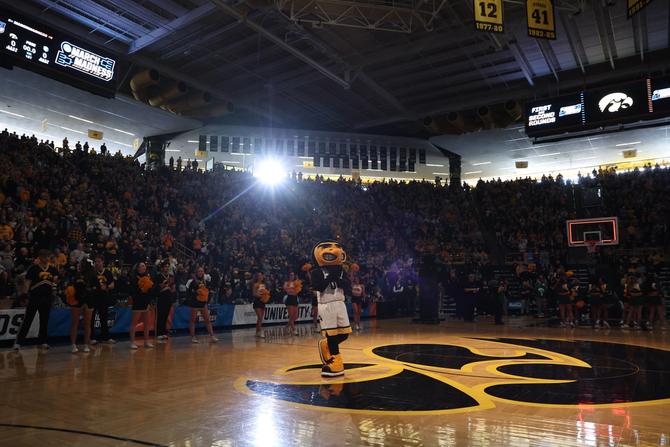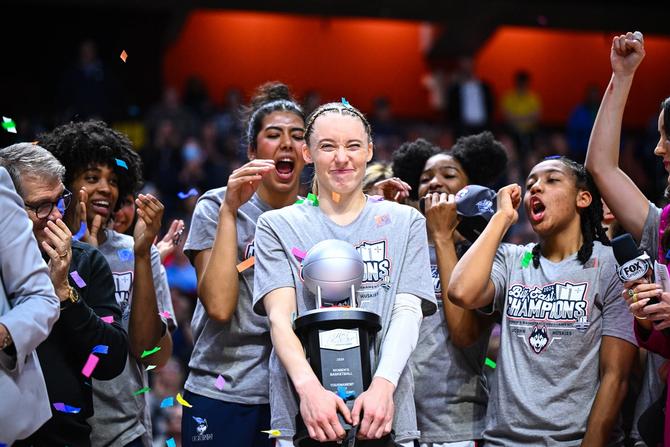Sunday Scroll: New high score, is that bad?
From The GIST (hi@thegistsports.com)

Happy First Sunday of March Madness!
With eighty combined matchups down, the men’s and women’s brackets have brought equal amounts of drama, buzzer beaters, and upsets.
- But equal is a relatively new concept for the tourney. Join us as we examine the recent and rapid growth on the women’s side.


— NBA Hall of Famer Kevin Garnett, discussing the hype around this year’s women’s tourney. Same, KG.
🔙 The backdrop

There have been many catalysts of change in the fight for equality in sports: Title IX and Billie Jean King winning the “Battle of the Sexes” are the first to often spring to mind, but Sedona Prince’s 2021 TikTok changed the game for women’s basketball (WBB) as we know it.
- The 37-second video from the then-Oregon forward not only documented the vast difference in the men’s and women’s weight rooms during the 2021 NCAA basketball championships, it also exposed a history of sexism in college sports that has left women’s athletics consistently underfunded and undervalued.
Public outrage following Prince’s series of Tik Toks prompted the NCAA to undergo a gender equity review that same year, and to no one’s surprise, the findings weren’t pretty. According to the review, the NCAA didn’t have a system or infrastructure in place to ensure gender equity, and its practices proved as much.
The NCAA’s business strategy was also flawed. It didn’t consider women’s sports to be revenue-producing *rolls eyes* and, as a result, limited the potential of women’s sports’ TV contracts, bundling them with 23 other championships in a media rights deal they sold to ESPN for $500M.
- This January, the NCAA negotiated a new media deal, once again bundling WBB with 39 other championships in spite of the recommendation from the previously mentioned third-party review that valued Women’s March Madness as $81 – $112M on their own.
Either way, the findings of the review were a wake-up call for the NCAA, which implemented some major changes as a result. In 2022, WBB finally enjoyed equal branding with MBB. Since then, the women’s tourney has been able to use the title “March Madness,” and both Final Fours now have either “Men’s” or “Women’s” in the official name.
- The update provided the women’s event with one of American sports’ most valuable marketing assets, increasing name recognition for fans and business opportunities for advertisers. Boom.
📈 The impact

Once the NCAA gave WBB the opportunity, there was no looking back. Coming off a very successful 2022, Women’s March Madness obliterated the record books last year.
- The championship game between LSU and Iowa, which was the first women’s championship aired on broadcast television since 1995, averaged 9.9M viewers and was, at the time, the most streamed sporting event on ESPN+ for men or women.
Even better, the trend is continuing this year. ESPN’s regular-season TV viewership increased 37% from 2023, while its broadcast of South Carolina–LSU drew more viewers than the NBA matchup between the Boston Celtics and Miami Heat that was airing at the same time.
Sponsors, of course, have taken note. For the third straight year, ESPN sold all of its advertising inventory before the women’s tourney even tipped off. And now that college athletes can sign name, image and likeness (NIL) deals with brands, WBB hoopers have taken advantage of the opportunity.
- Among all college basketball players, two of the top five NIL earners are women, with LSU’s Angel Reese and Flau’jae Johnson’s NIL valuations cashing in at $1.7M and $1.1M, respectively.
Together With The GIST
🎙️ Sound on

If you love The GIST’s newsletters, you’re going to love our twice-weekly podcast, The GIST of It. Hosted by besties Ellen Hyslop and Stephanie Rotz, it’s the women-produced and -hosted sports pod you’ve been waiting for. Talk about a golazo.
El and Steph dive into current sports topics and how they intersect with society and pop culture. They cover everything from season previews to calling out the sexist BS that’s rampant across the industry.
Join the conversation by subscribing to The GIST of It wherever you tune into podcasts. Happy listening.
🛑 The roadblocks

Demand for the women’s March Madness tournament is surging but certain logistical details can’t be ignored. The cost for a women’s Final Four championship ticket is $474 — around $100 more than the men’s — but that’s not the whole story.
- The women’s Final Four will take place at Cleveland’s Rocket Mortgage FieldHouse with a 19.5K capacity, while the men’s will be at Glendale’s 63.4K-seater State Farm Stadium. Locations are chosen years in advance, so these venues don’t reflect WBB’s rapid growth.
- Of the facilities chosen to host the women’s tournament through 2031, only one stadium, San Antonio’s Alamodome, has a capacity over 50K, and they’re not set to host until 2029. The next three Final Four sites can only fit up to 20.5K fans.
There’s also a huge gap between what coaches in MBB are paid compared to their WBB counterparts. Four-time national championship HC winner Kim Mulkey became the highest-paid bench boss in WBB after leading LSU to the title last season, inking a new salary worth $3.26M.
- While impressive, 31 men's coaches earn more than Mukley and Kansas' Bill Self earns three-times as much.
But there is hope on the horizon. Even though WBB was bundled with several other champions as mentioned above, the new $115M media rights deal with ESPN is roughly triple the amount of the contract that expires this year.
- Combined with the recent surge in popularity around women’s game and a still better if not great media deal, this will all hopefully lead to more money for the entire WBB ecosystem.
🆕 The evolving landscape

Women’s March Madness is poised to level up again in 2024 after the conference tournaments shattered records across the board: The Big Ten and SEC tournament championships drew viewership in the millions. Love to see it.
College hoops’ relationship with the WNBA is also evolving in the NIL era. Redshirt junior Paige Bueckers has already confirmed she’s returning to UConn, despite being projected as a top-3 pick in the 2024 WNBA Draft.
- Experts estimate that she’ll rake in more sponsorship dollars as a college athlete than a WNBA rookie, and she may not reach those financial heights again unless she becomes a star in the pros.
Still, her counterparts like Iowa’s Caitlin Clark, Stanford’s Cameron Brink and UConn’s Aaliyah Edwards who’ve declared for this year’s Draft are set bolster the WNBA’s profile, already bringing in new fans.
- Case in point? After Clark broke the all-time scoring record and dominated headlines across the country, ticket prices for the Indiana Fever, who own the No. 1 pick in the upcoming draft, have skyrocketed. In other words? Watch this space.
Giveaway Alert
The NCAA women's basketball tournament is truly living up to its hype so far, and with only two weeks left until the final, we’re giving away two tickets to the April 7th championship game in Cleveland, Ohio.
- And it’s not just tickets on the line — the winner will also receive $1,000 cash for travel and accommodation, plus Moolah Kicks Gear. Sound like a slam dunk? You know what to do — enter this contest today.
Here’s what has GIST HQ buzzing:
📩 What to subscribe to
The GIST’s women’s sports business newsletter. If you like what you read today, you’ll love reading about the business of women’s sports (for free!) three times a week.
🛒 What to add to cart
This iconic shirt. As seen on the one and only South Carolina HC Dawn Staley, you too can rock the tee.
🤑 What to read
This breakdown on the impact of NIL deals. Not only are college athletes getting paid for the first time, they’re changing the way schools and leagues are operating.
Today’s email was brought to you by Lauren Tuiskula and Rachel Fuenzalida. Editing by Lisa Minutillo. Fact-checking by Molly Potter. Operations by Marga Sison. Ads by Katie Kehoe Foster, Lauren Tuiskula and Dee Lab. Managing edits by Ellen Hyslop.